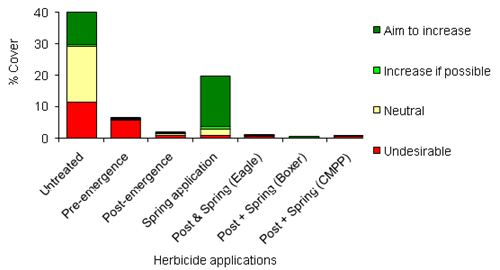 Most environmental stewardship options for farmland wildlife focus on the provision of habitats in field edges. However, some species (like the skylark) live in the crop and avoid field boundaries. Within the crop, weeds and seeds are key foods for farmland birds, insects and small mammals all year. But getting a good flora to benefit wildlife is difficult because any approach should not unduly affect the practicalities of farming.
Most environmental stewardship options for farmland wildlife focus on the provision of habitats in field edges. However, some species (like the skylark) live in the crop and avoid field boundaries. Within the crop, weeds and seeds are key foods for farmland birds, insects and small mammals all year. But getting a good flora to benefit wildlife is difficult because any approach should not unduly affect the practicalities of farming.
Our research on conservation headlands has demonstrated that some weeds are particularly beneficial to wildlife and that they can be managed without increasing the pernicious ones. These beneficial weeds are typically broad-leaved species that are not usually competitive with the crop. So the challenge is to see whether this idea can be extended to the whole crop, not just the headland.
As part of the SAFFIE project, we investigated whether lower herbicide inputs, wider row spacing or spring hoeing could do this in winter wheat. There is a theory that germination and weed growth are greater with wider row spacing because more light penetrates the crop, and that hoeing stimulates spring germination.
In conjunction with ADAS and the Central Science Laboratory, we studied small plots for three years at three sites differing in soil type. Herbicide treatments included untreated, full weed control, and a range of pre-emergence, post-emergence and spring-applied herbicides either applied in sequence or alone. These were adjusted according to soil type and the weed flora. The wide-spaced rows were twice the standard spacing of 12.5 centimetres, but with the same seed rate. We measured the abundance and diversity of weeds and seeds from all treatments. We also collected insects using a D-vac suction sampler during late June within each plot for four of the treatments. There were three replicates of each treatment in 2003 and five in the subsequent two years.
In all herbicide treatments, the abundance of beneficial weeds was almost always higher than that of the pernicious species. Weed levels remained very low, often less than 5% in all herbicide treatments, except in one year. Insect and spider abundance was usually highest where weed cover was greatest. Overall, the single spring application of amidosulfuron (Eagle) allowed most beneficial weeds to survive (see Figure 1) and frequently this treatment supported the most skylark food items (see Figure 2). The wide-spaced rows or spring hoeing had few consistent benefits.
Figure 1: Levels of weed cover at High Mowthorpe in 2005

Figure 2: Total weed cover and Skylark Food Insect (SFI) abundance at High Mowthorpe in 2005

This study indicates that there is scope to manipulate weed cover within winter wheat using herbicides, which should benefit farmland wildlife. Weed levels were lowest at the sites with sandy and chalky soils. Our next challenge is to identify threshold weed levels for different insects so that we can give better guidance on weed control and thresholds.